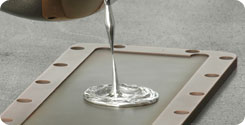AEM Target Bonding Introduction
The bonding process insures the thermal integrity of the interface between your system’s cooling assembly and the surface of the target, which experiences the most heat.
AEM provides a complete range of bonding services. Targets are sputter coated with two separate layers using an MRC Sputter Deposition System to match the expansion coefficient of the backing plate. Metallic bonding is available in various temperatures ranging from 150° to 225°C.
Types of Bonds
Indium Metal: AEM uses indium and indium based alloy materials for bonding. The melting temperatures for bonding materials range from 156°C to 225°C.
Silver Epoxy: For applications that require a significantly higher melting point than Indium, we can use a Silver loaded epoxy. Our Electrically Conductive Silver Epoxy is specially designed for target bonding.
Sizes and Shapes
We can easily bond most targets, in any size or shape. This includes round targets from 0.5″ to 16″ in diameter, rectangular targets from 1″ x 1″ to 10″ x 60″, ‘Delta’ targets, and other custom shapes.
Backing plates are available for the following systems
Perkin Elmer
MRC
Airco
Leybold
CVC
And Custom Designed Systems!
Backing Plate Material
- Oxygen-Free Copper: The most common backing plate material is Oxygen Free (OFHC) Copper. This metal has good electrical and thermal characteristics while also being easy to machine, easy to soften, and readily available at a low cost. Copper backing plates can be re-used, with care, 20 or more times.
- Molybdenum: For applications where Copper is not appropriate, we often substitute Molybdenum. For some materials, such as ceramics, or even metals made via Powder Metallurgy, the coefficient of expansion for Copper is mismatched. For applications where a high temperature bond is required, Copper may also oxidize badly or warp.
- Copper and Stainless Steel Cups: We specialize in the use of unique backing plate geometry for delicate ceramic targets ranging in size 0.5″ to 8″. The ‘cup’ design provides good mechanical support for the target on the back and around the edge. This improves both heat transfer to the cooling well of the cathode and increased mechanical integrity by providing a clamping point for the assembly which does not stress the target.


